Abstract
Reported are the environmental and demographic risk factors associated with the domestic infestation and density of Triatoma infestans in three heavily infested rural villages in Santiago del Estero Province, Argentina. In a one-factor unadjusted analysis, the number of T. infestans captured per person-hour was associated significantly and negatively with the use of domestic insecticides by householders, type of thatch used in the roofs and the age of the house; and positively with the following: degree of cracking of the indoor walls and presence of hens nesting indoors. In one model, using multiple linear regression and a backward stepwise elimination procedure, most of the variation in the overall abundance of T. infestans was explained by insecticide use and the presence of hens nesting indoors; in another model using the same procedure it was explained by insecticide use, bug density in 1988 and previous spraying with deltamethrin in 1985. Variations in bug density per capture stratum (household goods, beds, walls and roof) were explained by the bug density in other strata and by one or two of the following risk factors: hens nesting indoors, type of roof, presence of cracks in the walls and number of people living in the house. Bug density might be locally controlled by the availability of refuges in the roofs and walls, by the presence of hens nesting indoors and by the use of domestic insecticides. Certain local materials, such as a grass known as simbol, could be successfully used in rural housing improvement programmes aimed at reducing the availability of refuges for insects in the roof.
Full text
PDF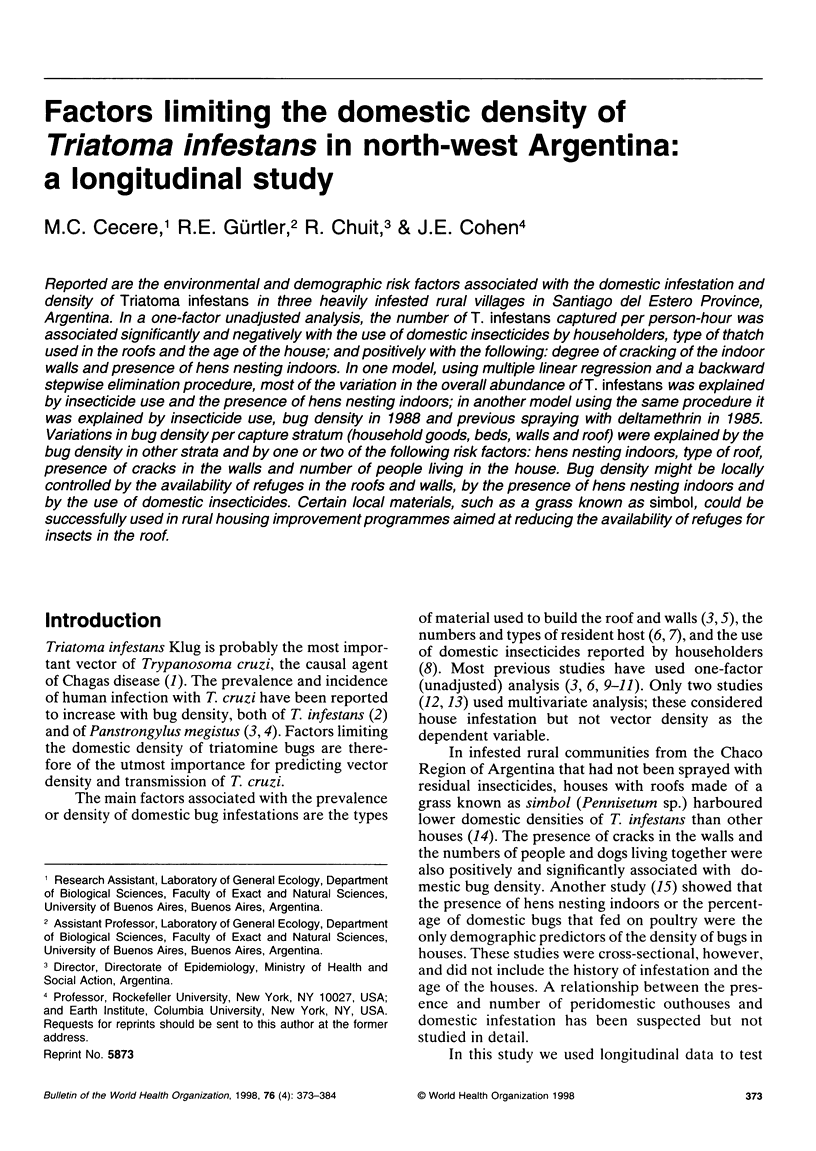
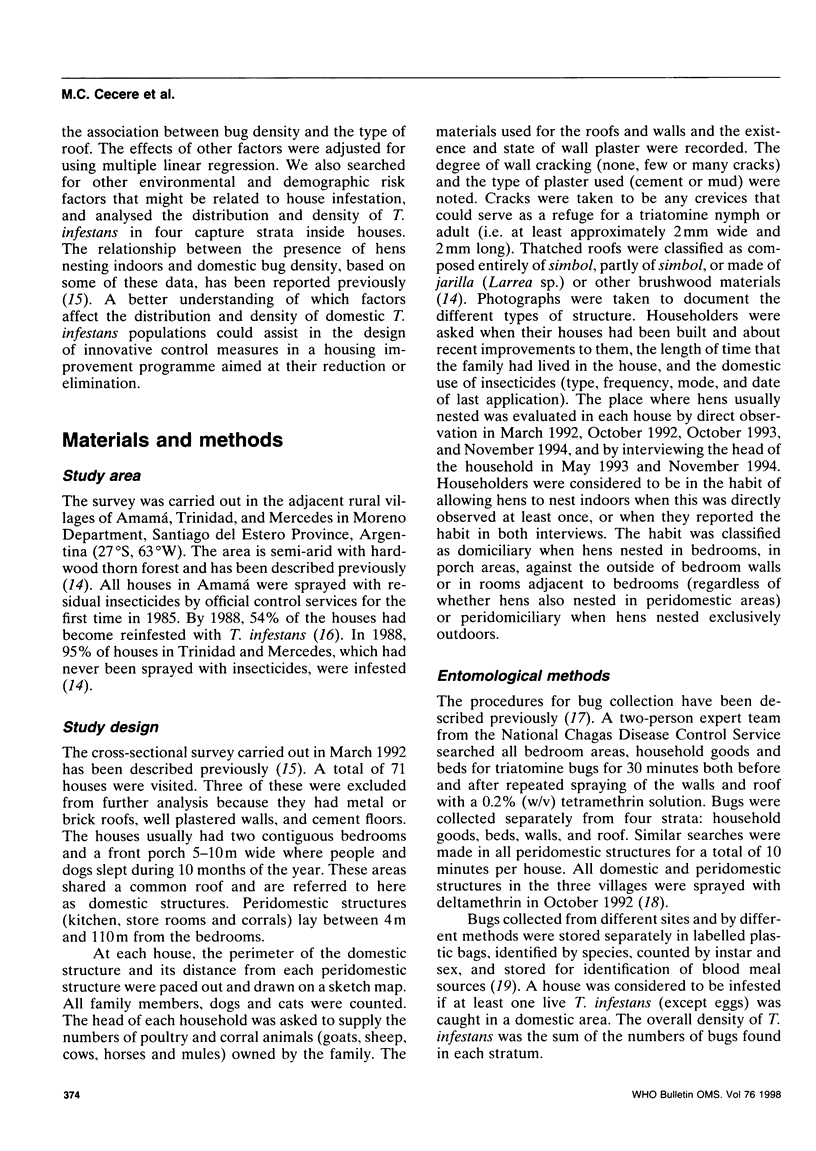
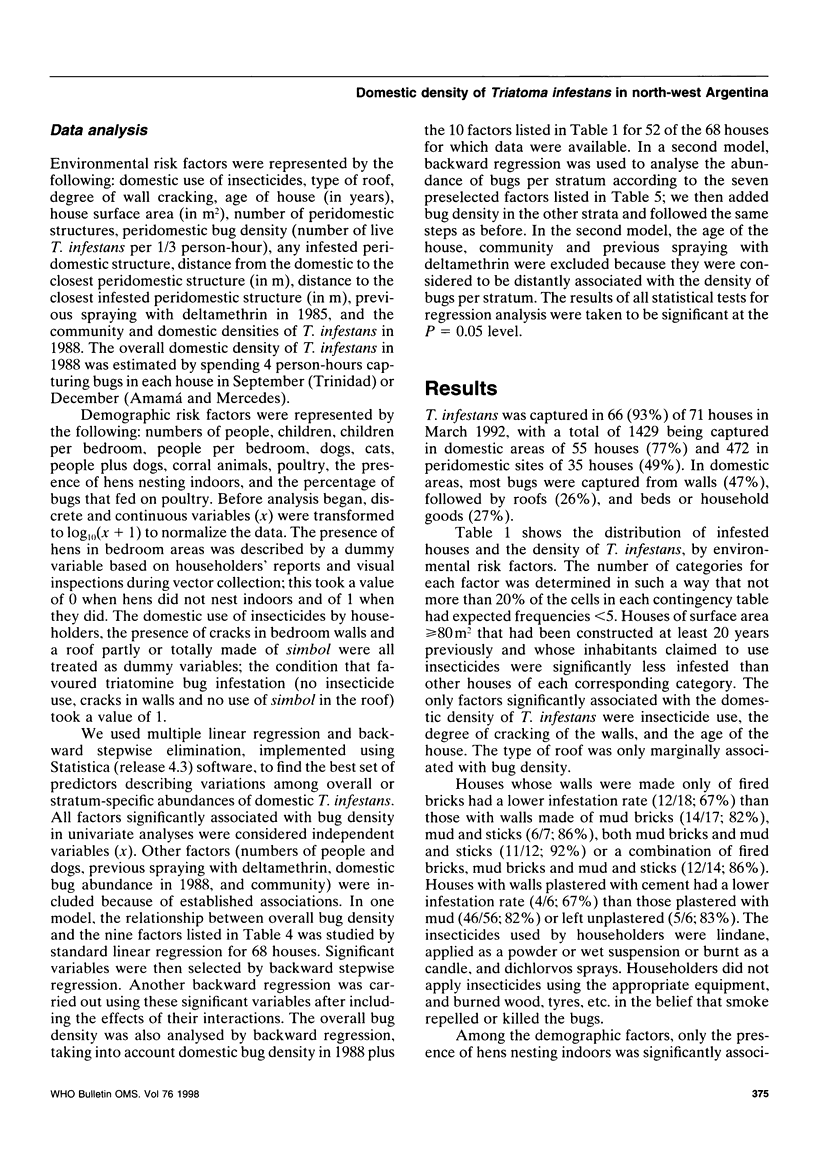
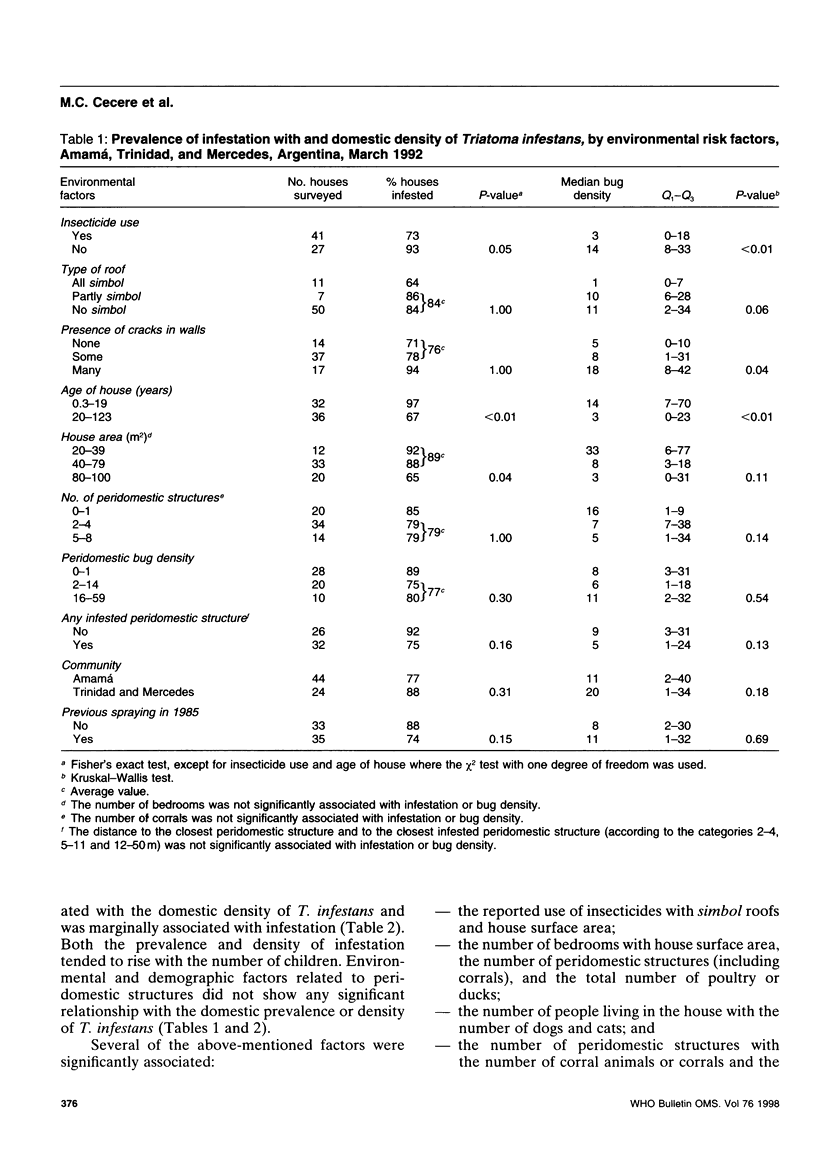
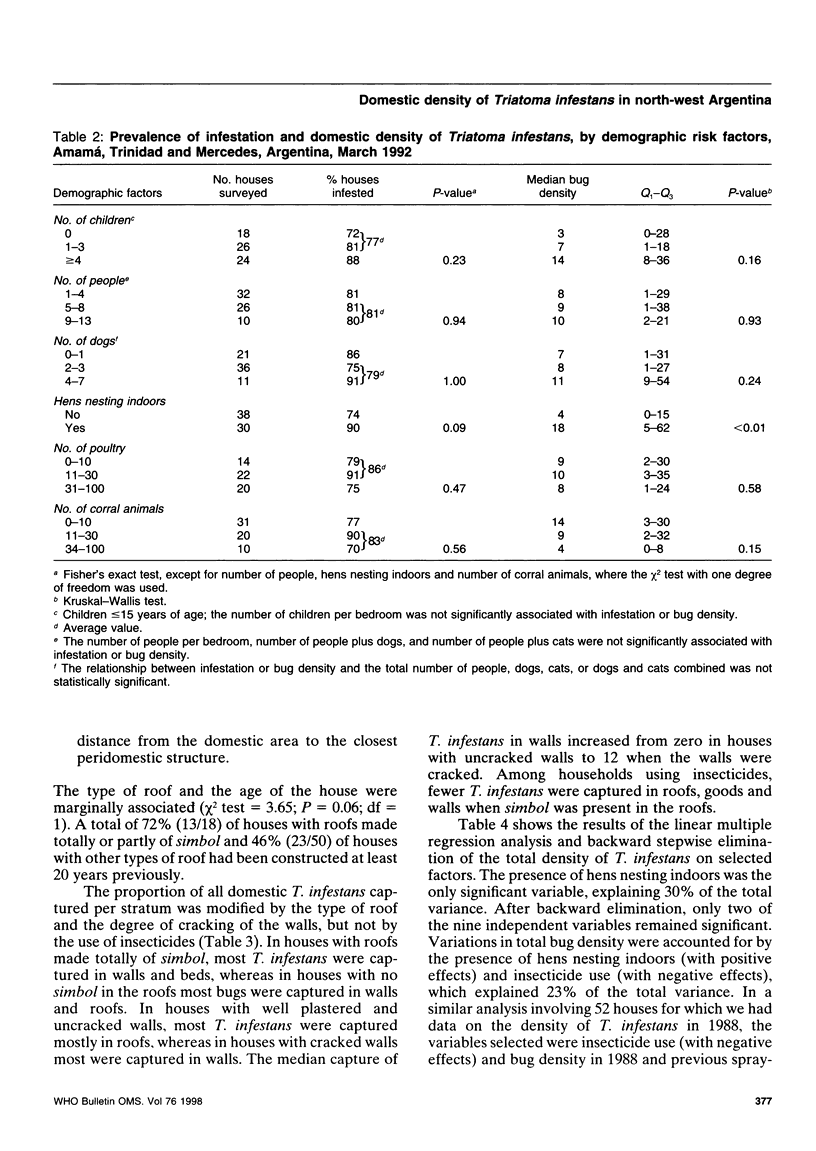
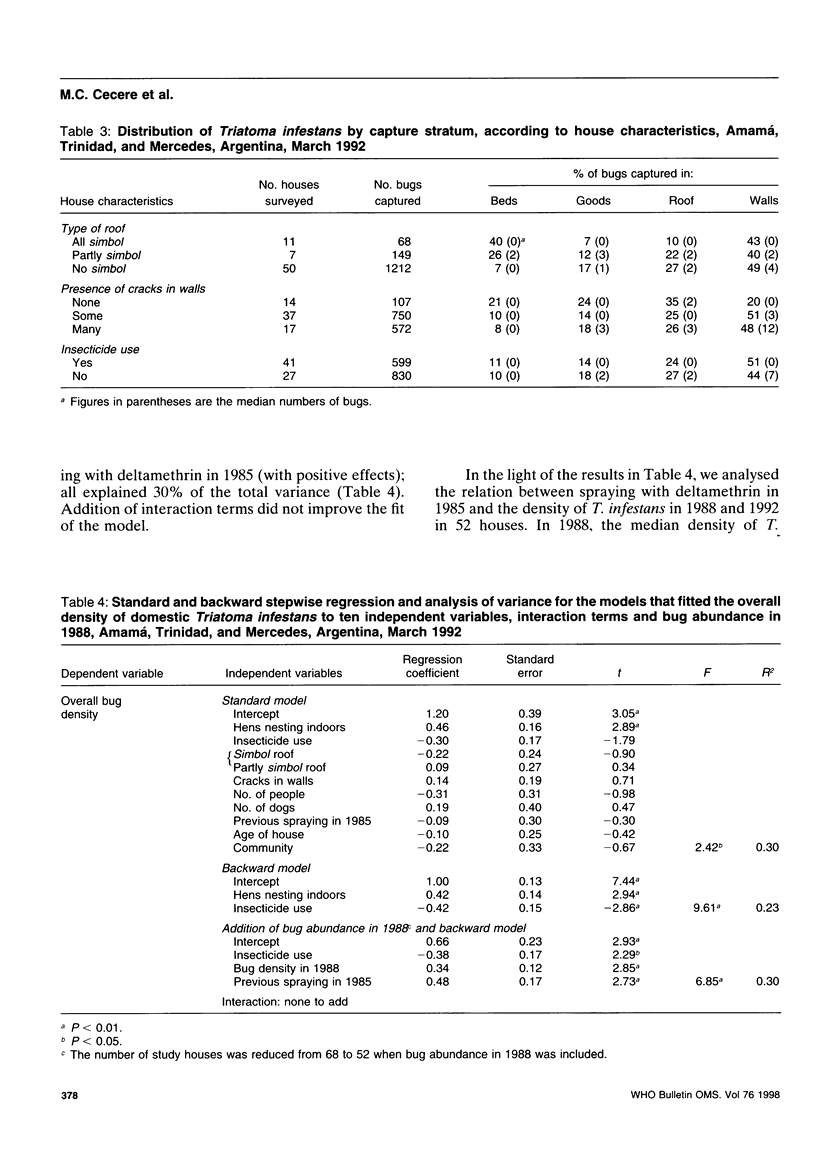
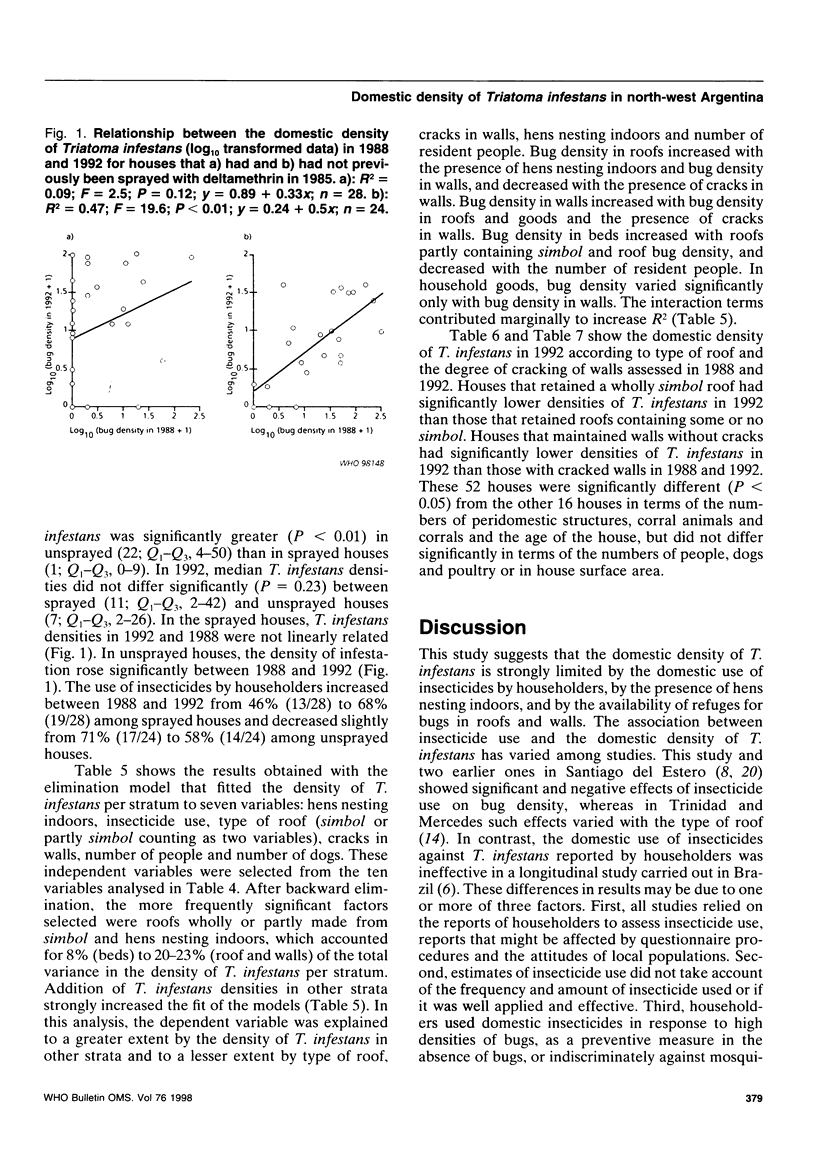
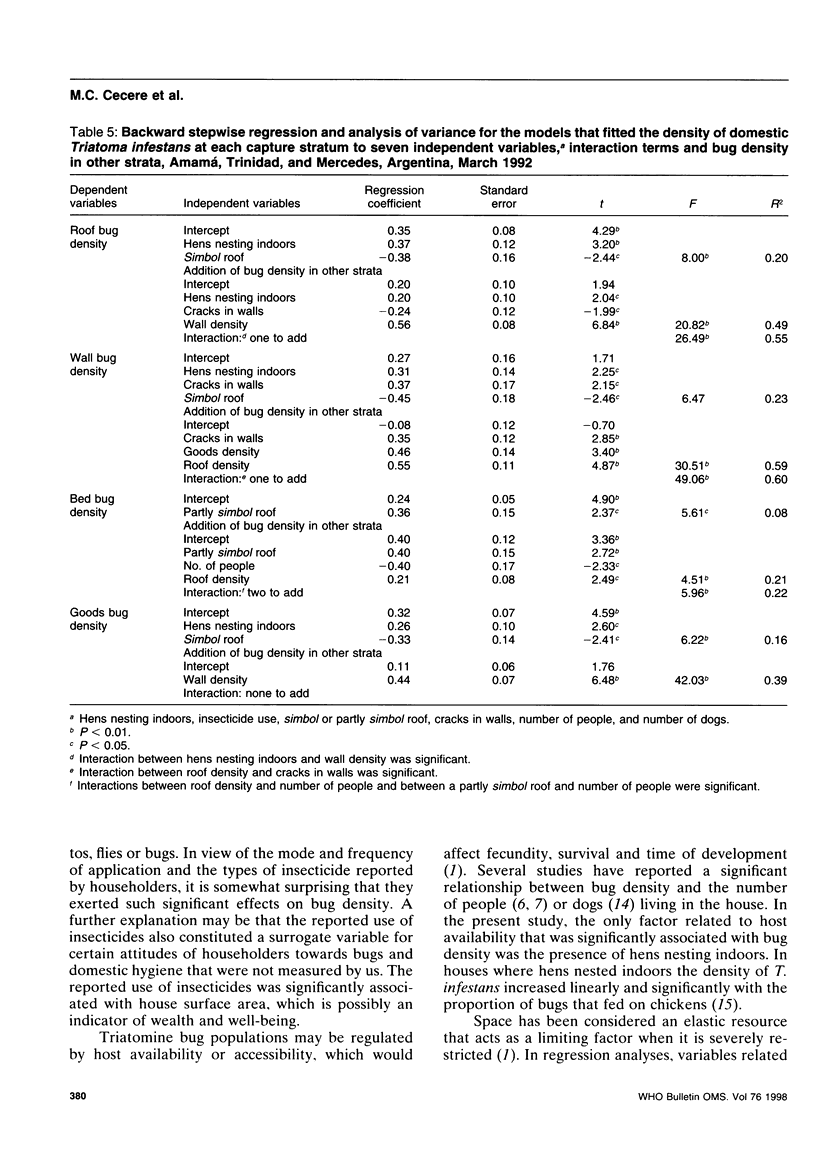
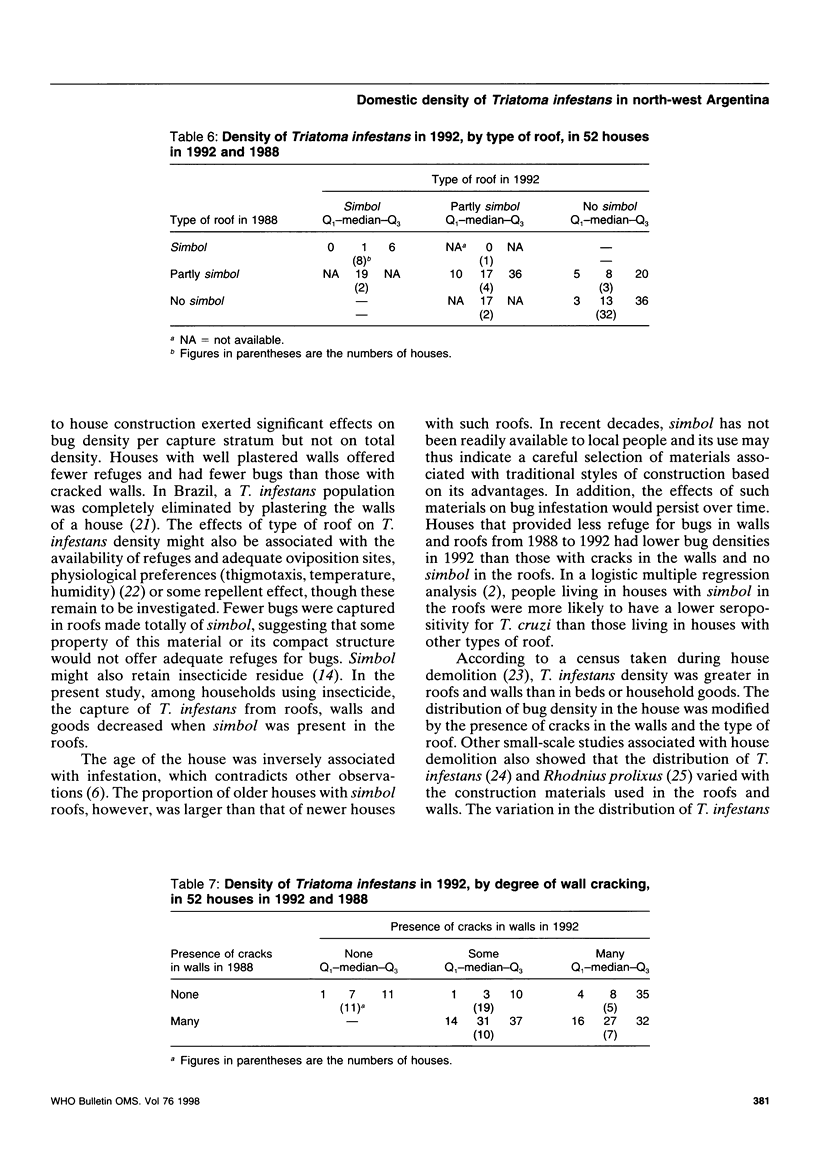
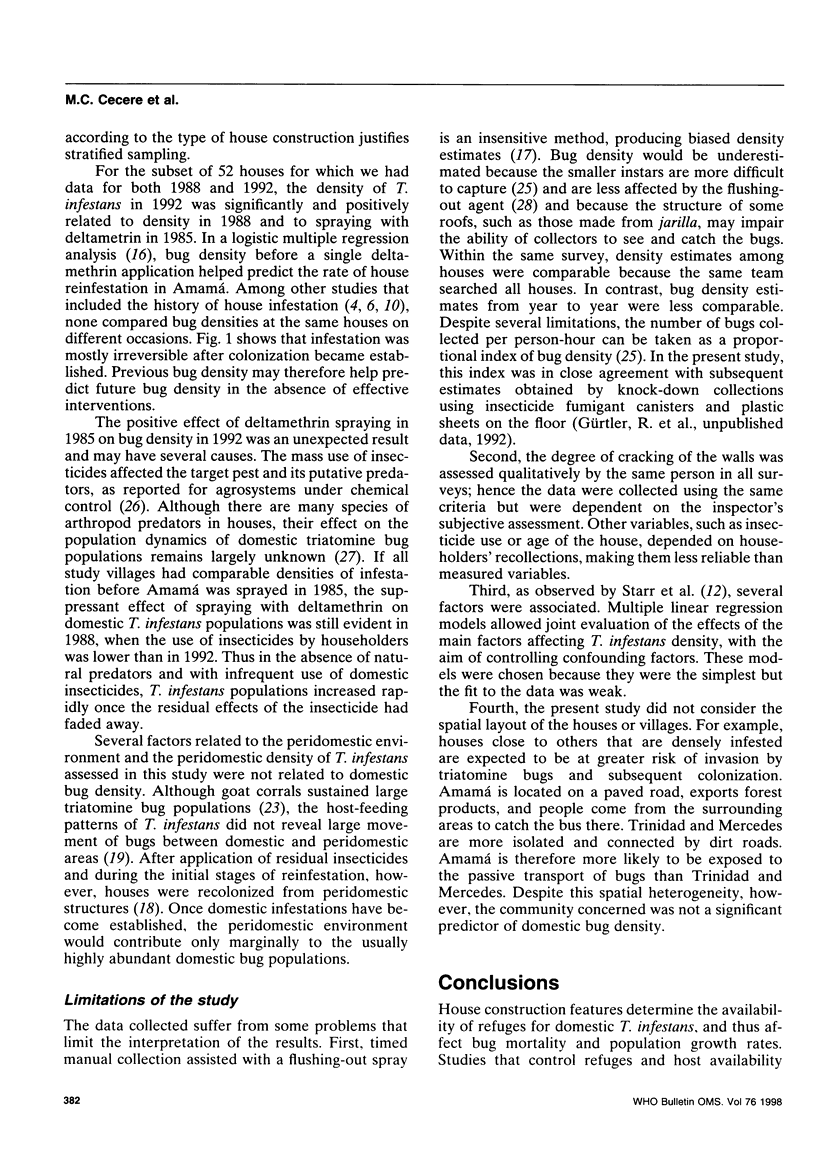
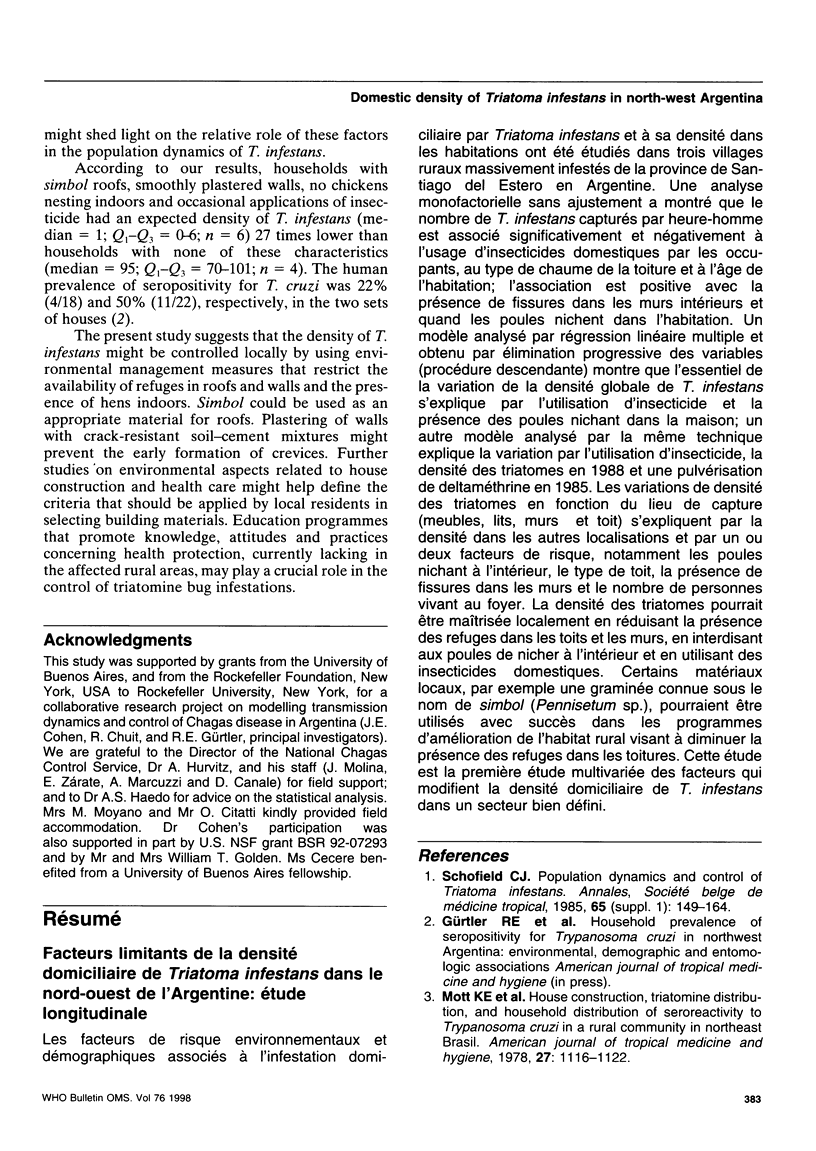
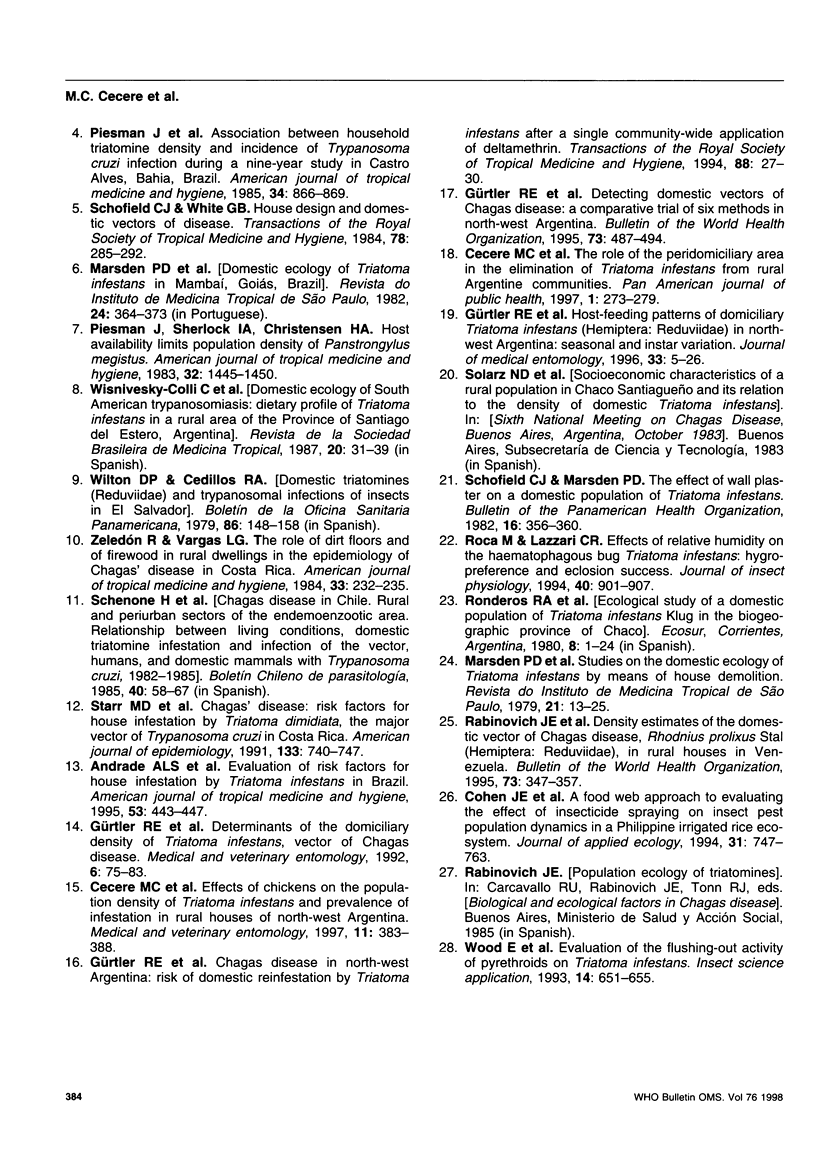
Selected References
These references are in PubMed. This may not be the complete list of references from this article.
- Cecere M. C., Gürtler R. E., Canale D., Chuit R., Cohen J. E. The role of the peridomiciliary area in the elimination of Triatoma infestans from rural Argentine communities. Rev Panam Salud Publica. 1997 Apr;1(4):273–279. doi: 10.1590/s1020-49891997000400003. [DOI] [PubMed] [Google Scholar]
- Cecere M. C., Gürtler R. E., Chuit R., Cohen J. E. Effects of chickens on the prevalence of infestation and population density of Triatoma infestans in rural houses of north-west Argentina. Med Vet Entomol. 1997 Oct;11(4):383–388. doi: 10.1111/j.1365-2915.1997.tb00426.x. [DOI] [PubMed] [Google Scholar]
- De Andrade A. L., Zicker F., De Oliveira R. M., Da Silva I. G., Silva S. A., De Andrade S. S., Martelli C. M. Evaluation of risk factors for house infestation by Triatoma infestans in Brazil. Am J Trop Med Hyg. 1995 Nov;53(5):443–447. doi: 10.4269/ajtmh.1995.53.443. [DOI] [PubMed] [Google Scholar]
- Gürtler R. E., Cecere M. C., Rubel D. N., Schweigmann N. J. Determinants of the domiciliary density of Triatoma infestans, vector of Chagas disease. Med Vet Entomol. 1992 Jan;6(1):75–83. doi: 10.1111/j.1365-2915.1992.tb00039.x. [DOI] [PubMed] [Google Scholar]
- Gürtler R. E., Chuit R., Cecere M. C., Castañera M. B. Detecting domestic vectors of Chagas disease: a comparative trial of six methods in north-west Argentina. Bull World Health Organ. 1995;73(4):487–494. [PMC free article] [PubMed] [Google Scholar]
- Gürtler R. E., Petersen R. M., Cecere M. C., Schweigmann N. J., Chuit R., Gualtieri J. M., Wisnivesky-Colli C. Chagas disease in north-west Argentina: risk of domestic reinfestation by Triatoma infestans after a single community-wide application of deltamethrin. Trans R Soc Trop Med Hyg. 1994 Jan-Feb;88(1):27–30. doi: 10.1016/0035-9203(94)90483-9. [DOI] [PubMed] [Google Scholar]
- Marsden P. D., Virgens D., Magalhães I., Tavares-Neto J., Ferreira R., Costa C. H., Castro C. N., Macedo V., Prata A. Ecologia doméstica do Triatoma infestans em Mambaí, Goiás-Brasil. Rev Inst Med Trop Sao Paulo. 1982 Nov-Dec;24(6):364–373. [PubMed] [Google Scholar]
- Mott K. E., Muniz T. M., Lehman J. S., Jr, Hoff R., Morrow R. H., Jr, de Oliveira T. S., Sherlock I., Draper C. C. House construction, triatomine distribution, and household distribution of seroreactivity to Trypanosoma cruzi in a rural community in northeast Brazil. Am J Trop Med Hyg. 1978 Nov;27(6):1116–1122. doi: 10.4269/ajtmh.1978.27.1116. [DOI] [PubMed] [Google Scholar]
- Piesman J., Sherlock I. A., Christensen H. A. Host availability limits population density of Panstrongylus megistus. Am J Trop Med Hyg. 1983 Nov;32(6):1445–1450. doi: 10.4269/ajtmh.1983.32.1445. [DOI] [PubMed] [Google Scholar]
- Piesman J., Sherlock I. A., Mota E., Todd C. W., Hoff R., Weller T. H. Association between household triatomine density and incidence of Trypanosoma cruzi infection during a nine-year study in Castro Alves, Bahia, Brazil. Am J Trop Med Hyg. 1985 Sep;34(5):866–869. doi: 10.4269/ajtmh.1985.34.866. [DOI] [PubMed] [Google Scholar]
- Rabinovich J. E., Gürtler R. E., Leal J. A., Feliciangeli D. Density estimates of the domestic vector of Chagas disease, Rhodnius prolixus Stål (Hemiptera: Reduviidae), in rural houses in Venezuela. Bull World Health Organ. 1995;73(3):347–357. [PMC free article] [PubMed] [Google Scholar]
- Schenone H., Contreras M. C., Borgoño J. M., Rojas A., Villarroel F., Valdés J. Enfermedad de Chagas en Chile. Sectores rurales y periurbanos del área de endemo-enzootia. Relaciones entre condiciones de la vivienda, infestación triatomídea domiciliaria e infección por Trypanosoma cruzi del vector, del humano y de mamíferos domésticos. 1982-1985. Bol Chil Parasitol. 1985 Jul-Dec;40(3-4):58–67. [PubMed] [Google Scholar]
- Schofield C. J., Marsden P. D. The effect of wall plaster on a domestic population of Triatoma infestans. Bull Pan Am Health Organ. 1982;16(4):356–360. [PubMed] [Google Scholar]
- Schofield C. J., White G. B. House design and domestic vectors of disease. Trans R Soc Trop Med Hyg. 1984;78(3):285–292. doi: 10.1016/0035-9203(84)90097-x. [DOI] [PubMed] [Google Scholar]
- Starr M. D., Rojas J. C., Zeledón R., Hird D. W., Carpenter T. E. Chagas' disease: risk factors for house infestation by Triatoma dimidiata, the major vector of Trypanosoma cruzi in Costa Rica. Am J Epidemiol. 1991 Apr 1;133(7):740–747. doi: 10.1093/oxfordjournals.aje.a115949. [DOI] [PubMed] [Google Scholar]
- Wilton D. P., Cedillos R. A. Los triatomineos domésticos (Beduvidos) y las infecciones tripanosómicas en insectos en El Salvador. Bol Oficina Sanit Panam. 1979 Feb;86(2):148–158. [PubMed] [Google Scholar]
- Wisnivesky-Colli C., Ruiz A. M., Ledesma O., Gütler R. E., Lauricella M., Salomón D. O., Solarz N., Segura E. L. Ecología doméstica de la tripanosomiasis americana: perfil alimentario del Triatoma infestans en un area rural de la provincia de Santiago del Estero, Argentina. Rev Soc Bras Med Trop. 1987 Jan-Mar;20(1):31–39. doi: 10.1590/s0037-86821987000100007. [DOI] [PubMed] [Google Scholar]
- Zeledón R., Vargas L. G. The role of dirt floors and of firewood in rural dwellings in the epidemiology of Chagas' disease in Costa Rica. Am J Trop Med Hyg. 1984 Mar;33(2):232–235. doi: 10.4269/ajtmh.1984.33.232. [DOI] [PubMed] [Google Scholar]


